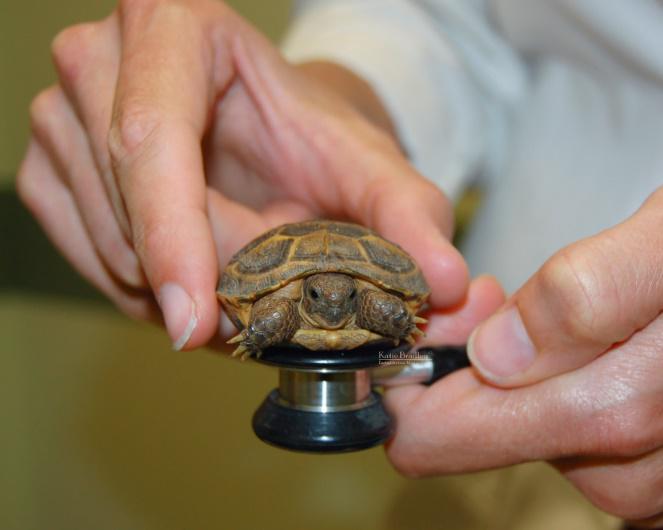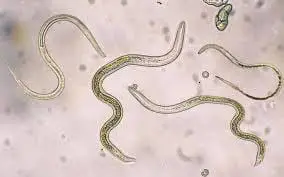Just like pet cats, dogs, birds and rabbits, tortoises, and turtles can be affected by intestinal parasites. Vets recommend taking a pet tortoise for a check-up at least once a year and also for regular deworming.
If you have a pet tortoise, it’s important that you deworm it regularly, understand how deworming works, and what are the precautions you need to take to prevent re-infestation.
Why deworm your tortoises?

All animals, even humans, have intestinal creatures, and a light load of these parasites may not be harmful. In fact, intestinal parasites may also help digest our food and thus may help enhance our health. In tortoises, a light load of some species of worms may not be harmful; however, a heavy load requires immediate treatment.
If deworming is not done, worms can multiply rapidly and can cause a lot of damage. These can cause malnutrition since the nutrition from the food that the tortoise eats will be ingested by these parasites. An example is a lowly roundworm, which can take 40% of the nutrients of the host animal. Large loads can lead to impaction in the gastrointestinal tract, pancreatic ducts, and bile ducts.
Tortoises suffering from an infestation can vomit worms or may also defecate worms. Sometimes tortoises can become weak, will be unable to eat or move because of an infestation. When you spot these signs and symptoms, it’s often too late. Therefore, pet owners should carefully observe their pets and take them to the vet for safe deworming regularly.
Common intestinal parasites in tortoises

It is still uncertain as to how many nematodes infect tortoises. But for most vets, most nematodes are not dangerous in tortoises compared to protozoa. Some reptilian nematodes can be seen easily by the naked eye; you might even find a few nematodes in the feces of your pets.
Roundworms
Roundworms are very common parasites in tortoises. These are parasitic and come with direct life cycles. Roundworms can be easily spotted by the naked eye when they turn into adults. In most cases, roundworms are passive in the GI tract; therefore, moderate numbers of roundworms may not pose as a risk for healthy and non-stressed animals.
Problems happened when a stressed, sick, or undernourished tortoise gets roundworm infestation because, as mentioned, roundworms can steal from the host 40% of the nutrients it gets from food. This can lead to secondary malnutrition, impaction especially from large loads and weakness of the animal.
Roundworm infections also pose another risk. The larvae of roundworms can move from one organ system to another to complete their life cycle. This can lead to ulcers and lesions in the lungs, the trachea, and other parts of the respiratory system. These lesions can become infected with bacteria and thus can lead to worse conditions for the host tortoise.
To diagnose the presence of roundworms, a microscopic examination of the feces is done. Finding eggs with thick walls in the feces of the tortoise is a positive sign for roundworms. When there is a heavy infestation, adult worms can be present in the tortoise’s feces or may be vomited.
You can tell that the tortoise has adult roundworms when you see round, white similar to strings of spaghetti. Each worm measures 10 to 150mm or ½ inch to 4 to 6 inches in length. When the larvae of roundworms travel to the lung of the tortoise, the animal may seem to try to regurgitate something in its throat. Also, the tortoise may sleep with its mouth open to breathe easy.
The treatment for roundworms vary, but the most common is Fenbendazole at 50 to 100 mg/kg of weight. This is given orally once every 2 weeks in two to three consecutive treatments. But take note that this dose is only a standard dose, and you still need to consult your vet for accurate dosage.
Pinworms
Meanwhile, pinworms are another common menace in tortoises. Some pet owners say that almost all the tortoises that they raised have pinworms even having infected from the time they got their pet from the store. Pinworms have a direct life cycle; tortoises get pinworms by drinking or eating any food that has been contaminated by fecal matter.
Pinworms are found in the lower parts of the gastrointestinal tract and usually don’t cause any upsetting diseases. But when there are high numbers of pinworms, then impaction may occur. Usually, it is very hard to tell if a tortoise has pinworms until these pests are passed in the tortoise’s feces.
Similar to diagnosing roundworms, the feces of the tortoise is examined under a microscope. Eggs must be present in the feces, usually floating about. It will take only a few hours for these eggs to cause an infection. Once worms have been observed in the feces, you can now positively say that other tortoises in the same enclosure have been infected.
The treatment for pinworms can vary, but a recommended dewormer is Panacur (fenbendazole). This is an oral dose at 50 to 100 mg/kg of weight every 2 to 3 weeks. This is administered continuously until there are no more pinworms found in the feces. And just like dealing with roundworms, this dose for pinworms is a standard dose, and you need to consult a vet regarding the ideal dose for your pet’s condition.
Taking a fecal test for worms
Diagnosing the presence of worms in tortoises is quite similar to diagnosing parasites in humans. You need to do a fecal test to
- Determine the presence of intestinal parasites
- Determine the kind of parasite/parasites present in the gut
- Determine the number of parasites present
- Determine the right type of treatment for the parasite present
A fecal test is initially done before any treatment, or deworming treatment is done. To get a sample of your pet’s feces, ready a clean or sterile spatula and a stool cup (both available in local drugstores). Take a sample of a newly pooped stool that has not touched the enclosure or any surface of the tank.
Take only a small amount and place this inside the stool cup. Cover the cup and label it with the name of your pet and the date. Take it to your vet immediately.
In examining stool for parasites, only a small amount is taken from the sample, enough to spread on a glass slide. This is examined under the microscope to check on the presence of parasites. Also, initial observation is done to check for observable parasites from the naked eye.
The color of the stool, the consistency, and the presence of blood or mucus are also noted by the examiner. Once the test is done, the results are printed and sent to your vet for evaluation. Your vet will also do a complete physical exam of your pet.
He will check the tortoise’s head, eyes, shell, belly, and his behavior. He will also interview you as the owner to ask for any signs and symptoms you have noticed during a week or a few weeks before treatment.
Common dewormers available for tortoises
If the vet has determined that your pet has worms, and he knows the specific type of worms, he will recommend one of the following treatments:
Panacur (Fenbendazole)
Panacur is the most popular drug used to treat all kinds of parasites, including roundworms, hookworms, whipworms, giardia, and other tapeworms. Panacur works by disrupting the metabolism and the cellular transport of the worm. This results in reducing the energy reserves of the parasite to remove waste until, eventually, it dies.
Panacur is only effective in living parasites and not on eggs; therefore, you should administer this medication again after a short time when the eggs that were once present have already hatched. Panacur is only available from a vet, and you cannot purchase it over the counter from any pet store or exotics store.
Flagyl (Metronidazole)
Another common dewormer is Flagyl. It is effective, but there is one thing wrong about it. It tastes really bad, and usually, pet owners have a hard time administering this to their pet because of the strong taste. Some pet owners’ advice is buying Flagyl made in Mexico, which is a citrus-flavored oral suspension that is more tolerable. You may also ask a vet or a pharmacist to make your pet an oral suspension in delicious flavors to mask the strong taste.
Flagyl works by stopping the development and destruction of DNA in the parasites. Compared to other dewormers, Flagyl is capable of crossing the blood-brain barrier of animals and therefore treating infections in the central nervous system.
Flagyl is also a dewormer in dogs. It will work in just 1 to 2 hours after administration. The effects will not be noticed immediately, but improvements may be seen after a few days. Metronidazole is available in tablet, capsule, and liquid suspension form. You may also have this compounded to improve its taste. Some vets administer Metronidazole intra-muscularly in case of severe infestations.
When given orally, you must administer this with food. Liquid forms should be shaken well before it is given to your pet.
Ronidazole
Ronidazole is another favorite dewormer among vets, but this is not available in the US. It is known as a safe and effective dewormer for cats, birds, and other pets and is classified as an antibiotic and antiprotozoal form of metronidazole. This is toxic to parasites as this can disrupt protozoa DNA. It is known to be more effective than metronidazole in the treatment of trichomonal infections in cats. Some research also claims its effectiveness in the treatment of Giardia in some animals.
Ronidazole is well-absorbed after oral administration. It is only available in compounding drug stores because it is not approved for animal or human use in the US. Most information regarding ronidazole is based on its use on cats and birds, but vets recommend this against pets that are pregnant or breastfeeding.
And to prevent toxicity, your pet’s accurate weight should be determined before this is administered. It is known to be carcinogenic, and therefore it is prohibited to be used on animals used as food. It can take as long as a month before there is a complete clearing of the pests in the tortoise’s body.
Tortoise Dewormer Plus (Flubendazole)
A popular dewormer is known as the Tortoise Dewormer Plus, which is Flubendazole-based. It is useful for the eradication of intestinal parasites like pinworms, threadworms, roundworms, tapeworms, and flukes. It is also effective against external parasites like ticks.
Tortoise Dewormer Plus is recommended before tortoises go into hibernation. It will control helminths and tapeworms to ensure that tortoises undergo a successful and stress-free hibernation. To administer this medication, sprinkle this on the tortoise’s food or add to the tortoise’s bathwater. You will find complete instructions on the medicine packet.
This dewormer is available in 5-gram packets. Use 0.3 grams or a level 0.5 scoop in 2 liters of lukewarm water. You can also sprinkle this in food. Place a sachet in one meal per tortoise. Mist warm water over the powder so it will stick to food. You must also consider the weight of your pet before administering the product to ensure that your tortoise is getting the most effective dose.
Do not give the following
Not all products or medications labeled as dewormers for vet use are safe for tortoises. Products like Ivomec (Ivermectin) and Albendazole, which are two known dewormers for cats and dogs, are very toxic to tortoises.
Also, if you know someone who has used a brand or dewormer medication, don’t immediately take their advice. As much as people are different, tortoises can be different as well. It’s still best to take your pet to the vet to have it’s checked. Only after taking a fecal test and a professional evaluation of your pet will a vet be able to provide a safe deworming product.
Deworming young tortoises
Young tortoises, as early as a few months, should be taken to the vet and dewormed. This is a very important thing to consider since juvenile tortoises may get these pests from their surroundings. Also, juvenile tortoises are very vulnerable because they may have not yet developed their immune systems. Usually, the same steps to safe deworming apply to juvenile tortoises.
Deworming calculator
Dewormers rely on the weight of the tortoise, and to make it easier to compute for the dose; you can use a deworming calculator. This is a sample of a deworming calculator from Panacur. This calculator is easy to use and will let you calculate the exact dose to prevent overdose and under dosage.
These calculators are from Panacur and are based on the different Panacur (Fenbendazole) doses of 2.5% and 10%. You may also find other worming calculators from other dewormer brands online.
Precautions during deworming
While your pet tortoise is undergoing deworming treatment, you should remember to preserve good hygiene. Your tortoise should prevent becoming re-infected with the parasite. The very first thing to do is to remove all substrate or bedding. Wear gloves and mask to prevent handling worms and worm eggs in the substrate.
Instead of using regular bedding or substrate, use newspapers so that these will be easy to remove and to clean. Replace this substrate every day. Give your tortoise a bath daily using warm water. Warm water can also stimulate bowel movement.
Clean the tortoise’s enclosure. Worms and other parasites can’t stand ordinary cleaning products, but make sure that you scrub well and rinse with hot water. Remove every single accessory inside the enclosure and wash these with warm soapy water.
If your enclosure has a water feature, remove it and clean the area well with warm soapy water and brush it well.
If you have two or more tortoises in one enclosure, quarantine the sick one or the newly dewormed one. This is very important, especially if all your pet’s companions have not been treated yet. Make sure that the quarantine enclosure is also clean, with good ventilation and temperature. You can only introduce the tortoise to the enclosure after all of them have been treated. This is why it’s best not just to have one or two cages or enclosures at home.
If your tortoise lives outdoors in an outdoor enclosure, take it inside in an indoor enclosure during his treatment. This is so because, despite treatment and following all the precautionary measures, your pet can still easily get re-infected outdoors.
As your tortoise is being treated indoors, prepare the outdoor enclosure by moving it in an area with cement or paved floors. Scrub the enclosure well with warm soapy water and brush. Pay extra attention to the feeding bowls, drinking bowls, and any water feature because worms can easily hide in these areas and re-infect your pet. And just like indoor tortoises, quarantine your infected outdoor tortoise as it undergoes treatment.
Deworming all your pet tortoises
As a rule, if you have two or more tortoises and one is positive for parasitic infestation, then you must deworm them all. You can’t take chances because the lives of your pets depend on it. Sometimes, some vets require every tortoise in the enclosure to get tested, although some say that this is unnecessary and just a waste of time. If one tests positive, then it’s likely every tortoise is infested.
When to begin? All of your pet tortoises should start deworming at the same time. In this case, there’s no need to quarantine one from the others. But still, thorough cleaning and sterilizing of their enclosure is needed. Don’t forget to clean all the accessories, remove the bedding, and use it easy to clean and remove the substrate.
Nutrition after during deworming
As mentioned, your infested pet tortoise has been robbed of nutrition by these pesky pests. But as the parasites are cleared, and the infestation clears up as well, your pet will soon gain his normal appetite and will surely improve its weight.
It’s time to give it food that is rich in protein, minerals, and vitamins, especially calcium supplements. Calcium is needed for strong bones and bone development; also, it is important to avoid metabolic bone disease. Give your pets fresh and clean vegetables and fruits. Soak these in apple cider vinegar for at least 15 minutes to remove any pests that may be found on the surface.
Give your tortoise clean water that it can drink and maybe soak from. Since tortoises and turtles potty in water, you should clean their cage water twice a day. Make sure that all food dishes and water dishes are clean before you feed your pet.
Can tortoise parasites infect humans?
Parasites like worms that infect tortoises and other domesticated pets cannot harm humans because we have a different physiology from tortoises. But still, when handling tortoises feces and urine, or cleaning their enclosure, wear gloves and a face mask.
You are more likely to be at risk of getting a disease known as Salmonella. Salmonella is found in all reptiles, including tortoises and turtles. Humans can get Salmonella from the feces of the animal. For instance, you cleaned your tortoise’s cage and removed his feces without washing your hands thoroughly after. Salmonella causes headaches, fever, cramps, and diarrhea, and worse, it can lead to blood poisoning or septicemia. If this is not treated right away, you can suffer from dehydration.
There were around 440 cases of salmonellosis in 2008, with 15 of these having contact with reptiles. Children are more susceptible to acquiring salmonellosis because they tend to forget to wash their hands after handling their pets.
Another condition is botulism, which is a life-threatening condition due to the toxin that is released by Clostridium bacteria. When not treated right away, botulism can cause paralysis and death. Animals that live in very close to the ground like tortoises can have clostridium bacteria and is more common in aquatic reptiles.
Frequent handwashing can help control the incidence of salmonella and botulism. Overall cleanliness, the right nutrition, and good husbandry can help control worms and other parasites in your pet tortoise.



